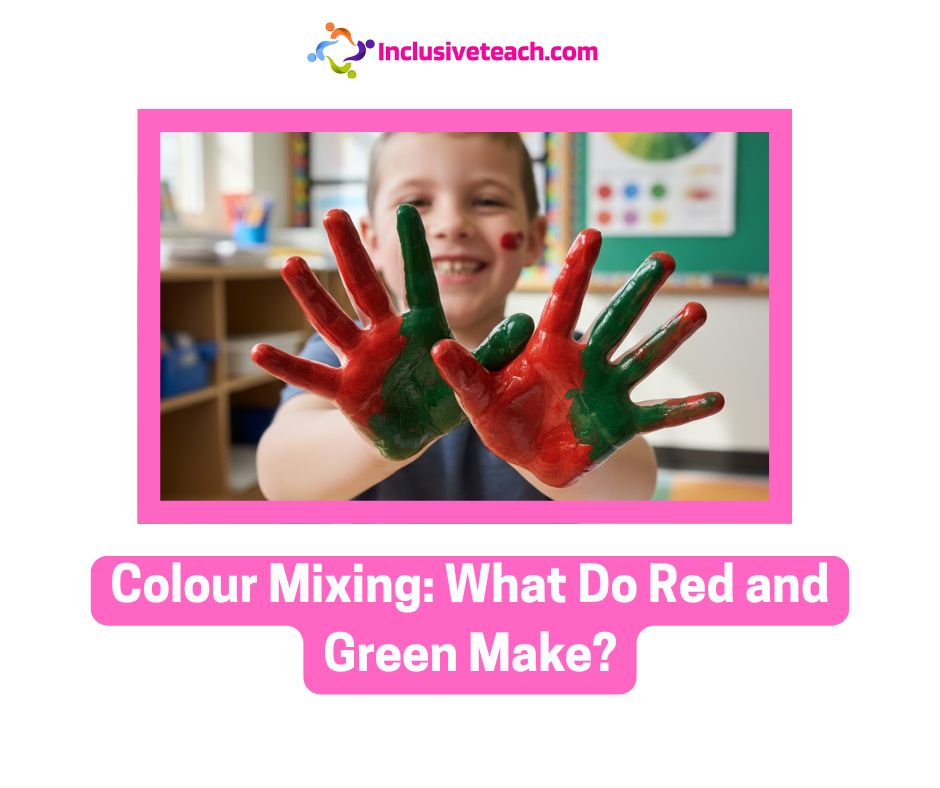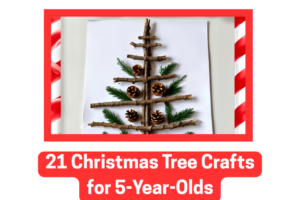
What Do Red and Green Make?
Every single year, in every single classroom, a teacher hears the question: “What happens if I mix these two colors?” It seems so simple, doesn’t it? Kids, with their perpetually paint-stained fingers and boundless curiosity, just want to know the outcome. You might think the answer is a straightforward Orange or Purple, but honestly, when it comes to red and green, the answer is actually a little bit of a secret.
You know what? The most accurate answer is that it depends entirely on how you mix them. Are you mixing paint, which is pigment? Or are you mixing pure light? The results, I’m telling you, couldn’t be more different. One is a beautiful, vibrant surprise that powers the screen you’re reading this on, and the other is… well, let’s just call it muddy practicality.
You may also like our Colours Sensory Story.

Wait, What’s the Big Secret? Pigments and the Subtractive System
If you take a dollop of red paint and mash it together with a glob of green paint—this is where most kindergarten experiments land—you are engaging with the subtractive color system. And here’s the thing: those two gorgeous colors don’t make another bright color. Instead, you get a somewhat underwhelming, often dark, brown.
But why brown? That’s the real lesson. In the world of paint and art, red and green are considered complementary colors, they are opposites on the traditional RYB (Red, Yellow, Blue) color wheel. When you mix any two complementary colors, what you’re really doing is telling the pigments to absorb all the light.
When a light beam (which contains all colors) hits red paint, the red pigment absorbs everything except the red light, which it reflects back to your eye. Green paint does the same thing, absorbing everything but green. When you mix them, the resulting brown pigment is soaking up almost all the visible light spectrum. It’s like a visual tug-of-war where both sides are so strong they just cancel each other out, leaving you with that deep, earthy brown. It’s a very practical color, mind you, used for everything from tree trunks to dirt, but it’s certainly not the bright new hue most expect.

But I Heard They Make Yellow?
Now, maybe you’ve heard that red and green make yellow, and honestly, you’re not totally wrong! That’s where the mild contradiction comes in, and that’s why this topic is so fascinating. Many people confuse the traditional art primaries (Red, Yellow, Blue) with the actual primaries of light (Red, Green, Blue). If you’re thinking about paint, mixing red and green definitely won’t get you yellow—you need to mix a little red and yellow to get that classic orange, or blue and yellow to get green.
However, the idea that red and green make yellow is completely, scientifically accurate… when you change the medium entirely. The confusion is warranted because we operate in two very different color realms every day: the world of physical objects (paint, printing ink, clothes) and the world of light (TVs, phones, stage lights). Let me explain.
Seeing the Light: The Additive System (The True Science)
This is the part of the lesson where you can truly watch students’ jaws drop. When you mix light—not paint—you switch to the additive color system. And in this system, Red light plus Green light makes a beautiful, vibrant Yellow light.
Why? Because for light, red, green, and blue (RGB) are the actual primary colors. They are the building blocks of every color you see on any digital screen. When you shine a beam of red light onto a white surface and overlap it perfectly with a beam of green light, your brain perceives the combination as yellow. This isn’t a muddy approximation; it’s a pure, luminous hue.
Think about your television screen for a moment. If you look closely at a pixel, you’ll see tiny red, green, and blue dots. When the screen wants to show you a yellow taxi, the red and green dots turn on at full power, and the blue dot stays off. The light from the red and green emitters combines, adding their wavelengths together, and your eye translates this combined signal into the color yellow. It’s truly a physics marvel, and honestly, it blows kids’ minds every time you demonstrate it
Bringing the Magic to the Classroom: Simple Activities
The best way to teach this concept is to make students do it. You need to show them both outcomes, side-by-side, so they can feel the fundamental difference between light and pigment. Here are a few engaging, high-impact activities that are easy to set up.
Activity 1: Swamp Thing Brown Paint Mix (Subtractive)
This is a classic hands-on activity. Give students a small dollop of red tempera or acrylic paint and a similar-sized dollop of green.
- Materials: Red and green paint, paper plates, craft sticks.
- Procedure: Stress that they need to start small. Have them mix a small bit of red with a small bit of green. Watch as the new color emerges. Then, have them mix the full amounts. The key is to observe the transition from two vibrant colors to a muted, deep brown.
- Vocabulary Focus: Discuss the term complementary colors. Use a little humour and call the resulting color “Tree Bark Brown” or “Deep Earth.” Ask them: “Can you still see the red? Can you still see the green?” The answer, of course, is no. It’s a great visual metaphor for cancellation.
Activity 2: The Yellow Light Trick (Additive)
This activity requires a slightly darker room, but the “wow” factor is worth the effort.
- Materials: Two flashlights (even small ones work), red cellophane or plastic filters, green cellophane or plastic filters, and rubber bands to attach the filters. A blank, white wall.
- Procedure: Darken the room. Have one student hold the red light and another the green light. Shine both beams onto the wall separately. Then, slowly overlap the two circles of color. As the red light and green light combine, the overlapping section will instantly turn yellow.
- Science Focus: Use this moment to talk about the RGB model. Tell them, “This is what makes your phone screen work!” It’s a direct, undeniable visual proof of the additive system. This helps cement the idea that color is as much about physics as it is about art.
Activity 3: The Emotion and Pop of Opposites
Now that they know what happens when red and green mix (brown), and what happens when red and green light mix (yellow), explore why these two colors are often seen together without mixing.
- Materials: A simple color wheel (even a hand-drawn one).
- Procedure: Point out that red and green are directly opposite each other on the wheel. This opposition makes them pop. When they are right next to each other—like in a traffic light, on a Christmas sweater, or even in a picture of a red flower against green leaves—the contrast is intense.
- Emotional Cues: Discuss the emotional impact. Red often means urgency, passion, or warning. Green means nature, calm, or “go.” Why do we pair these opposites? Because they command attention! This creates a natural digression into the psychology of color.
Why This Matters More Than Just a Little Brown Paint
It might seem like a frivolous lesson, just another craft project. But understanding the difference between the subtractive (pigment) and additive (light) color systems is actually pivotal to making sense of the entire modern visual world.
Think about how your printer works. It uses Cyan, Magenta, Yellow, and Key (CMYK), all subtractive pigments, to create millions of colors from those four. When your printer mixes cyan and yellow, it subtracts wavelengths to leave you with green. It’s the same basic principle as the red and green paint making brown. Conversely, every single image you view on a computer or phone relies on the additive Red, Green, Blue light model.
Free Red and Blue Colour Mixing Generator Tool!
Related
Discover more from Special Education and Inclusive Learning
Subscribe to get the latest posts sent to your email.
Source link



